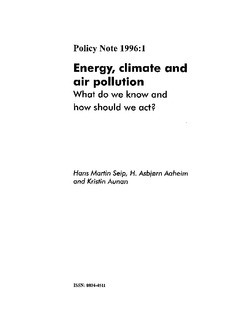Energy, climate and air pollution: What do we know and how should we act?
Working paper
Permanent lenke
http://hdl.handle.net/11250/191858Utgivelsesdato
1996Metadata
Vis full innførselSamlinger
- CICERO Policy Notes [65]
Sammendrag
- To arrive at the most cost-effective strategies to reduce emissions an integrated approach is necessary. This implies to carry out detailed analyses of harmful effects on human health, materials and the ecosystems.
- By using an integrated approach it may be possible to solve local problems and at the same time reduce the emission of greenhouse gasses. Mitigation of man-made climate changes may therefore turn out to be less expensive than most earlier studies indicate.
- The value of a given environmental quality will vary over time and is likely to increase during economic growth.
- The discount rate for investments in abatement should be different from that used for investments in production. During economic growth the former will in general be lower.
- Legal, institutional, organizational and social constraints to effective control strategies must be considered.
- Close interdisciplinary cooperation is necessary, e.g. between natural scientists, social scientists and economists.
